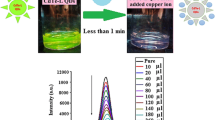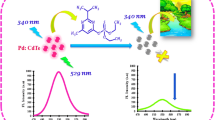Abstract
Nowadays, the major concerns to human health are toxic heavy metal contamination. So, there has been an urgent requirement for trustworthy and quick methods for the detection of hazardous heavy metal ions in the water samples. Over the past two decades, Quantum dots (QDs) have been developed as sensitive sensors, due to their unique luminescence property. In the present work, we have developed a rapid, cheap and water-soluble thioglycolic acid (TGC) capped CdTe quantum dot (QD) sensor for the detection of Cu2+ hazardous heavy metal ions in water. By using one-step method, water-soluble TGC capped CdTe QDs have been prepared. TGC capped QDs were characterized by different spectroscopy techniques. Time and temperature dependency on the fluorescence response were observed. In the presence of Cu2+metal ions, a strong “Turn-Off” fluorescence response is detected. A strong 1:1 complexation (Cu2+: TGC capped CdTe QDs) between TGC capped CdTe QDs and metal ion were verified by the output of Benesi–Hildebrand relation and Job’s plot. Our findings suggested that TGC capped CdTe QD shows better response towards Cu2+ metal ions and can be used for the detection of Cu2+ metal ions in water medium.







Similar content being viewed by others
References
Y. Chen, Z. Rosenzweig, Luminescent CdS Quantum Dots as Selective Ion Probes, Anal. Chem. 74 (2002) 5132–5138.
P. Zrazhevskiy, M. Sena, X. Gao, Designing Multifunctional Quantum Dots for Bioimaging, Detection, and Drug Delivery. Chemical Society Reviews, 39 (2020), 4326-4354.
A.J. Nozik, M.C. Beard, J.M. Luther, M. Law, R.J. Ellingson, J. C. Johnson, Semiconductor Quantum Dots and Quantum Dot Arrays and Applications of Multiple Exciton Generation to third-Generation Photovoltaic Solar Cells. Chemical Reviews, 110 (2010), 6873-6890.
Reineke, S. (2015). Complementary LED Technologies. Nature Materials, 14 (5) 459-462.
M.D. Gonz´alez, A.D.L.E. Muniz, M.T.F. Argüelles, F.J.G. Alonso, J.M.C. Fernandez, Quantum Dot Bioconjugates for Diagnostic Applications, Surface-Modified Nanobiomaterials for Electrochemical and Biomedicine Applications (2020) 133--176.
S. Chin, S. Tan, S. Pang, S. Ng, Nitrogen Doped Carbon Nanodots as Fluorescent Probes for Selective Detection and Quantification of Ferric (III) ions, Opt. Mater. 73 (2017) 77–82.
A. Lesiak, K. Drzozga, J. Cabaj, M. Bański, K. Malecha, A., Podhorodecki, Optical Sensors Based on II-VI Quantum Dots. Nanomaterials, 9 (2019) 192.
D. Raeyani, S. Shojaei, S. Ahmadi Kandjani, W. Wlodarsk, Synthesizing Grapheme Quantum Dots for Gas Sensing APPLICATIONS, ProcediaEng 168 (2016) 1312–1316.
M.H. Lai, Antioxidant Effects and Insulin Resistance Improvement of Chromium Combined with Vitamin C and E Supplementation for Type 2diabetes Mellitus, J. Clin. Biochem. Nutr. 43 (2008) 191–198.
V. Arancibia, M. Valderrama, K. Silva, T. Tapia, Determination of Chromium in Urine Samples by Complexation-Supercritical Fluid Extractionand Liquid or Gas Chromatography, J. Chromatogr. B. 785 (2003) 303–309.
D. S. Rodas, W. T. Corns, B. Chenbm, P. B. Stockwel, and Atomic Fluorescence Spectrometry: A Suitable Detection Technique in Speciation Studies for Arsenic, Selenium, Antimony and Mercury, Journal of Analytical Atomic Spectrometry 25 (2010) 933–946.
M. Zeeb, M.R. Ganjali, P. Norouzi, Pre Concentration and Trace Determi-nation of Chromium Using Modified Ionic Liquid Cold-Induced Aggregation Dispersive Liquid-Liquid Micro Extraction: Application to Different Water and Food Samples, Food Anal. Methods. 6 (2012) 1398–1406.
S. Wu, N. C. Sekar, S.N. Tan, H. Xie, S.H. Nang, Determination of Chromium(iii) by Differential Pulse Stripping Voltammetry at a Chitosan-Gold Nanocomposite Modified Screen Printed Electrode, Anal. Methods. 8 (2016) 962–967.
J. S. Lee, Y. H. Youn, I.K. Kwon, N. R. Ko, Recent Advances in Quantum Dots for Biomedical Applications, Journal of Pharmaceutical Investigation. 48 (2018) 209–214.
P. S. Hariharan, S. P. Anthony, A. Sivasubramanian, Off-on Fluorescent Sensor from On-off Sensor: Exploiting Silver Nanoparticles Influence on the Organic Fluorophore Fluorescence, J. Fluoresc. 24 (2013) 319-327.
K. Ponnuvel, G. Banuppriya, V. Padmini, Highly Efficient and Selective Detection of Picric Acid Among Other Nitroaromatics by NIR Fluorescent Organic Fluorophores, Sensors and Actuators B: Chemical. 234 (2016) 34-45.
J. Tang, R.A. Marcus, Determination of Energetics and Kinetics from Single-Particle Intermittency and Ensemble-Averaged Fluorescence Intensity Decay of Quantum dots, J. Chem. Phys. 125 (2006) 044703.
M. Rana, P. Chowdhury, L-Glutathione Capped CdSeS/ZnS Quantum Dot Sensor for the Detection of Environmentally Hazardous Metal Ions. J. Lumin. 206 (2019) 105-112.
N.A.A. Anas, Y.W. Fen, N.A.S. Omar, W.M.E.M.M. Daniyal, N.S.M. Ramdzan, S. Saleviter, Development of Graphene Quantum Dots-Based Optical Sensor for Toxic Metal Ion Detection. Sensors, 19 (2019) 3850.
M. Rana, A. Jain, V. Rani, P. Chowdhury, Glutathione Capped Core/Shell CdSeS/ZnS Quantum Dots as a Medical Imaging Tool for Cancer Cells, Inorganic Chemistry Communications 112 (2020) 107723.
E.M. Ali, Y. Zheng, H.H. Yu, J.Y. Ying, “Ultrasensitive Pb2+ Detection by Glutathione Capped Quantum Dots,” Anal. Chem. 79 (2007) 9452–9458.
S.D. Caruthers, S.A. Wickline, G.M. Lanza, Nanotechnological Applications in Medicine, Current Opinion in Biotechnology 18 (2007) 26–30.
A. Riedinger, F. Zhang, F. Dommershausen, C. R¨ocker, S. Brandholt, G. U. Nienhaus, U. Koert, W.J. Parak, Ratiometric Optical Sensing of Chloride Ions with ORGANIC Fluorophore–Gold Nanoparticle Hybrids: A Systematic Study of Design Parameters and Surface Charge Effects, Small 22 (2010) 2590–2597.
K. Ponnuvel, G. Banuppriya, V. Padmini, Highly Efficient and Selective Detection of Picric Acid Among other Nitroaromatics by NIR Fluorescent Organic Fluorophores, Sensors and Actuator B: Chemical 234 (2016) 34–45.
U.R. Genger, M. Grabolle, S.C. Jaricot, R. Nitschke, T. Nann, Quantum Dots Versus Organic Dyes as Fluorescent Labels, Nat. Methods 5 (2008) 763–775
U. R. Genger, M. Grabolle, S. C. Jaricot, R. Nitschke, T. Nann Quantum Dots Versus Organic Dyes as Fluorescent Labels, Nature Methods. 5(2008) 763–775.
Pooja, M. Rana and P. Chowdhury, Influence of Size and Shape on Optical and Electronic Properties of CdTe Quantum Dots in Aqueous Environment, AIP Conference Proceedings. 2136 (2019) 040006.
L. Spanhel, M. Haase, H. Weller, A. Henglein, Photochemistry of Colloidal Semiconductors Surface Modification and Stability of Strong Luminescing CdS Particles, J. Am. Chem. Soc. 109 (1987) 5649–5655.
Z. Hooshyar, G. R. Bardajee, Fluorescence Enhancement of Glutathione Capped CdTe/ZnS Quantum Dots by Embedding into Cationic Starch for Sensitive Detection of Rifampicin, Spectrochimica Acta Part A: Molecular and Biomolecular Spectroscopy, 173 (2017) 144-150.
M.J. Almendral-Parra,A. Alonso-Mateos, J.F. Boyero-Benito, S. Sánchez-Paradinas, E. Rodríguez-Fernández, A Novel Approach to the Fabrication of CdSe Quantum Dots in Aqueous Solution: Procedures for Controlling Size, Fluorescence Intensity, and Stability Over Time, Journal of Nanomaterials 2014 (2014).
C. Y. Huang, Determination of Binding Stoichiometry by the continuous Variation Method: The Job Plot, Methods in Enzymology. 87 (1982) 509-525
R. L. Scott, Some Comments on the Benesi‐Hildebrand Equation. Recueil des Travaux Chimiques des Pays‐Bas, 75 (1956), 787-789.
Author information
Authors and Affiliations
Corresponding author
Additional information
Publisher's Note
Springer Nature remains neutral with regard to jurisdictional claims in published maps and institutional affiliations.
Rights and permissions
About this article
Cite this article
Rana, M., Devlal, K. Thioglycolic Acid Capped CdTe Quantum Dots as Sensors for the Detection of Hazardous Heavy Metal Ion Cu2+ in Water. MAPAN 37, 41–46 (2022). https://doi.org/10.1007/s12647-021-00479-5
Received:
Accepted:
Published:
Issue Date:
DOI: https://doi.org/10.1007/s12647-021-00479-5




